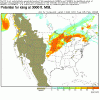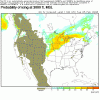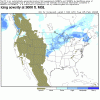tonycondon
Gastons CRO (Chief Dinner Reservation Officer)
tommorow morning 12Z departure at Ames, IA. Des Moines TAF:
so weather will be above minimums for the ILS and Localizer
approaches, as well as the VOR/DME.
Winds Aloft forecast for 3,6,9 thousand feet for 0900 to 1800 Z:
+2 at 6000 feet looks encouraging.
Area Forecast for Iowa:
Forecast Icing Potential at 3000 feet is shown next. 1000 and
5000+ show no potential for icing.

to compliment that chart here is the Forecast Icing Potential from the Experimental ADDS site for 1100Z (closest available):

Seems that the charts are of the same form, but the Experimental version has at least a 20% lower chance of icing than the chart from the mainstream site. Oh here is the forecast icing severity from Experimental ADDS too:

So the way im seeing it so far is somewhere between a 50 and 100% chance of light ice at 3000. The RUC Sounding for 1200 Z at Ames:

I can see the 700ish AGL ceilings, followed by what seems to me to be "thin" (not fully saturated) clouds with tops around 3600 MSL. So it seems about a 2000 foot thick layer of possible icing. Would the slight temp/dew point spread be what is holding the experimental FIP from going to the 75-100%? There is a little bit of above freezing temps up there around 5000 thanks to the inversion that is dying. Even the next hours sounding shows temps right around zero going up, never greater than.
So whats the call? I would like to see a couple things before I was really comfortable departing in this:
1) It would be nice if the mainstream CIP/FIP came down on their probability from the 75-100% range
2) If they didnt, the severity in the Trace range would be good
3) more warmer air aloft to help shed any ice that may be picked up on the quick trip through the layer.
4) being darn sure that ceiling and vis would hold so I wouldnt have any worries about getting home on the first try!
How about you?
KDSM 050529Z 050606 33010KT 3SM BR OVC003
FM1200 35010KT 1 1/2SM BR OVC007
FM1800 36012KT 1SM -SN BR OVC003
FM2300 36015G22KT 1/2SM SN BLSN FG OVC001
so weather will be above minimums for the ILS and Localizer
approaches, as well as the VOR/DME.
Winds Aloft forecast for 3,6,9 thousand feet for 0900 to 1800 Z:
DSM 0321 3108+02 2622-02
+2 at 6000 feet looks encouraging.
Area Forecast for Iowa:
IA
CIG OVC010 TOP 050. VIS 3SM BR. 13Z CLDS LYRD FL180. OTLK...IFR
CIG BR BECMG IFR CIG SN FG 18Z-20Z.
Forecast Icing Potential at 3000 feet is shown next. 1000 and
5000+ show no potential for icing.
to compliment that chart here is the Forecast Icing Potential from the Experimental ADDS site for 1100Z (closest available):
Seems that the charts are of the same form, but the Experimental version has at least a 20% lower chance of icing than the chart from the mainstream site. Oh here is the forecast icing severity from Experimental ADDS too:
So the way im seeing it so far is somewhere between a 50 and 100% chance of light ice at 3000. The RUC Sounding for 1200 Z at Ames:
I can see the 700ish AGL ceilings, followed by what seems to me to be "thin" (not fully saturated) clouds with tops around 3600 MSL. So it seems about a 2000 foot thick layer of possible icing. Would the slight temp/dew point spread be what is holding the experimental FIP from going to the 75-100%? There is a little bit of above freezing temps up there around 5000 thanks to the inversion that is dying. Even the next hours sounding shows temps right around zero going up, never greater than.
So whats the call? I would like to see a couple things before I was really comfortable departing in this:
1) It would be nice if the mainstream CIP/FIP came down on their probability from the 75-100% range
2) If they didnt, the severity in the Trace range would be good
3) more warmer air aloft to help shed any ice that may be picked up on the quick trip through the layer.
4) being darn sure that ceiling and vis would hold so I wouldnt have any worries about getting home on the first try!
How about you?






